FORD F150 2013 12.G Owners Manual
Manufacturer: FORD, Model Year: 2013, Model line: F150, Model: FORD F150 2013 12.GPages: 570, PDF Size: 6.13 MB
Page 261 of 570
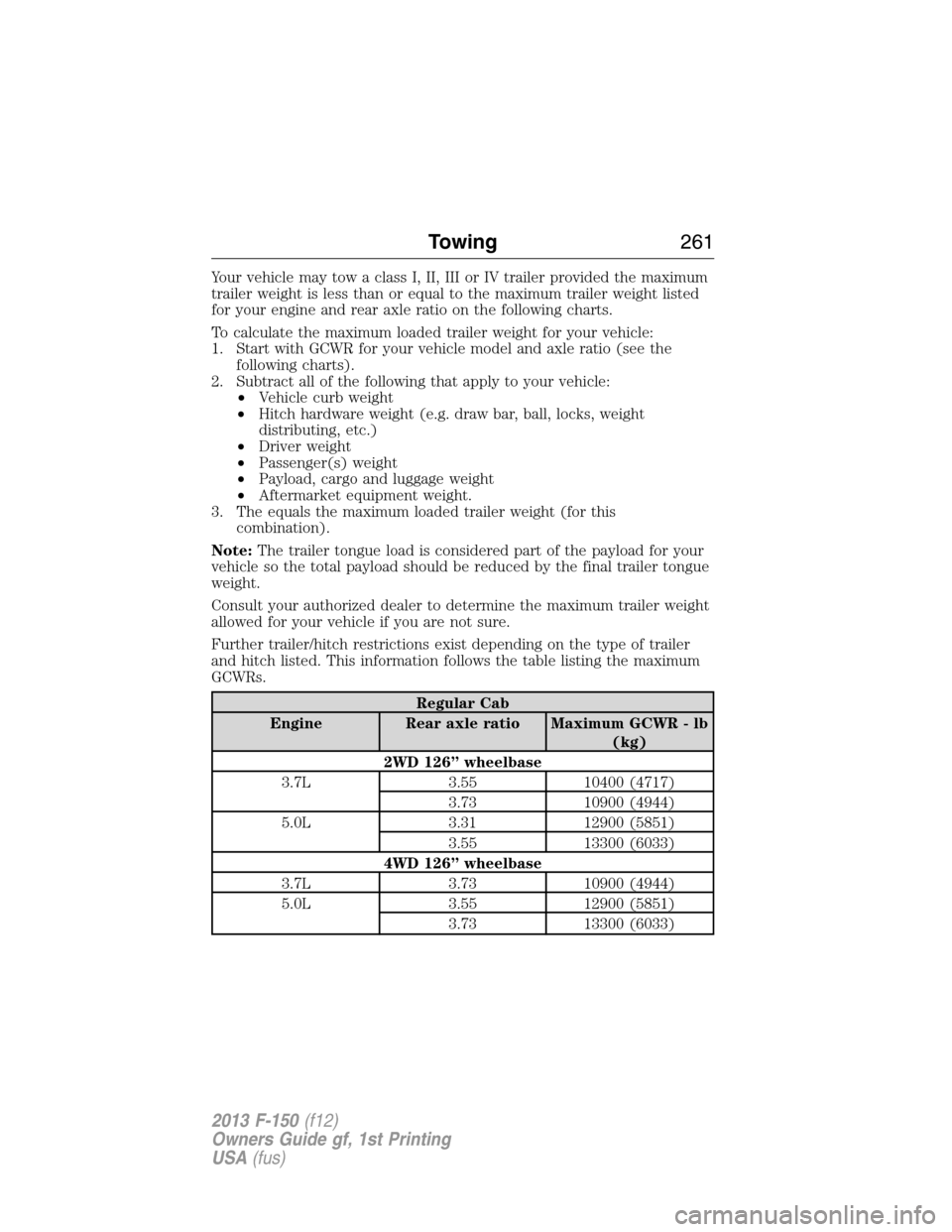
Your vehicle may tow a class I, II, III or IV trailer provided the maximum
trailer weight is less than or equal to the maximum trailer weight listed
for your engine and rear axle ratio on the following charts.
To calculate the maximum loaded trailer weight for your vehicle:
1. Start with GCWR for your vehicle model and axle ratio (see the
following charts).
2. Subtract all of the following that apply to your vehicle:
•Vehicle curb weight
•Hitch hardware weight (e.g. draw bar, ball, locks, weight
distributing, etc.)
•Driver weight
•Passenger(s) weight
•Payload, cargo and luggage weight
•Aftermarket equipment weight.
3. The equals the maximum loaded trailer weight (for this
combination).
Note:The trailer tongue load is considered part of the payload for your
vehicle so the total payload should be reduced by the final trailer tongue
weight.
Consult your authorized dealer to determine the maximum trailer weight
allowed for your vehicle if you are not sure.
Further trailer/hitch restrictions exist depending on the type of trailer
and hitch listed. This information follows the table listing the maximum
GCWRs.
Regular Cab
Engine Rear axle ratio Maximum GCWR - lb
(kg)
2WD 126” wheelbase
3.7L 3.55 10400 (4717)
3.73 10900 (4944)
5.0L 3.31 12900 (5851)
3.55 13300 (6033)
4WD 126” wheelbase
3.7L 3.73 10900 (4944)
5.0L 3.55 12900 (5851)
3.73 13300 (6033)
Towing261
2013 F-150(f12)
Owners Guide gf, 1st Printing
USA(fus)
Page 262 of 570
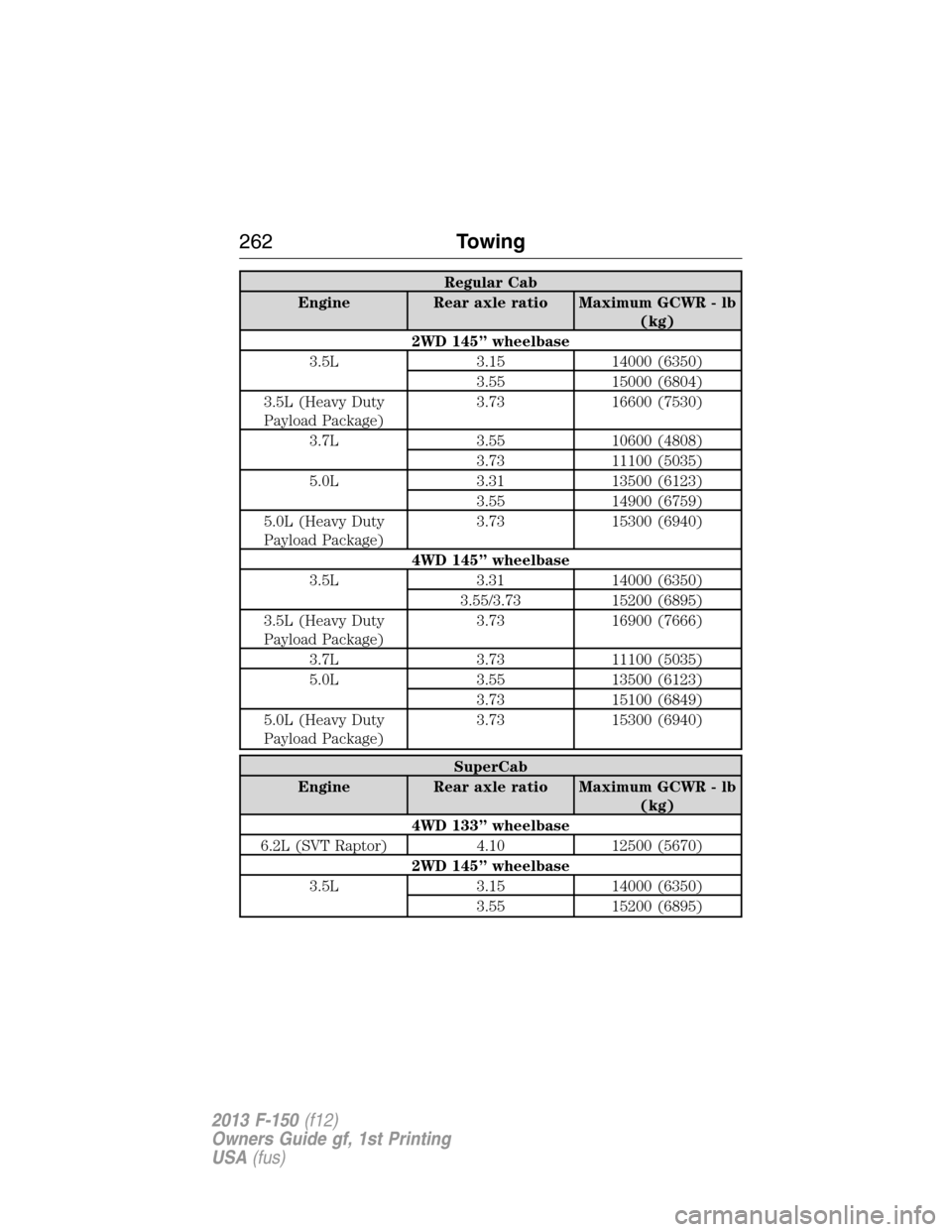
Regular Cab
Engine Rear axle ratio Maximum GCWR - lb
(kg)
2WD 145” wheelbase
3.5L 3.15 14000 (6350)
3.55 15000 (6804)
3.5L (Heavy Duty
Payload Package)3.73 16600 (7530)
3.7L 3.55 10600 (4808)
3.73 11100 (5035)
5.0L 3.31 13500 (6123)
3.55 14900 (6759)
5.0L (Heavy Duty
Payload Package)3.73 15300 (6940)
4WD 145” wheelbase
3.5L 3.31 14000 (6350)
3.55/3.73 15200 (6895)
3.5L (Heavy Duty
Payload Package)3.73 16900 (7666)
3.7L 3.73 11100 (5035)
5.0L 3.55 13500 (6123)
3.73 15100 (6849)
5.0L (Heavy Duty
Payload Package)3.73 15300 (6940)
SuperCab
Engine Rear axle ratio Maximum GCWR - lb
(kg)
4WD 133” wheelbase
6.2L (SVT Raptor) 4.10 12500 (5670)
2WD 145” wheelbase
3.5L 3.15 14000 (6350)
3.55 15200 (6895)
262Towing
2013 F-150(f12)
Owners Guide gf, 1st Printing
USA(fus)
Page 263 of 570
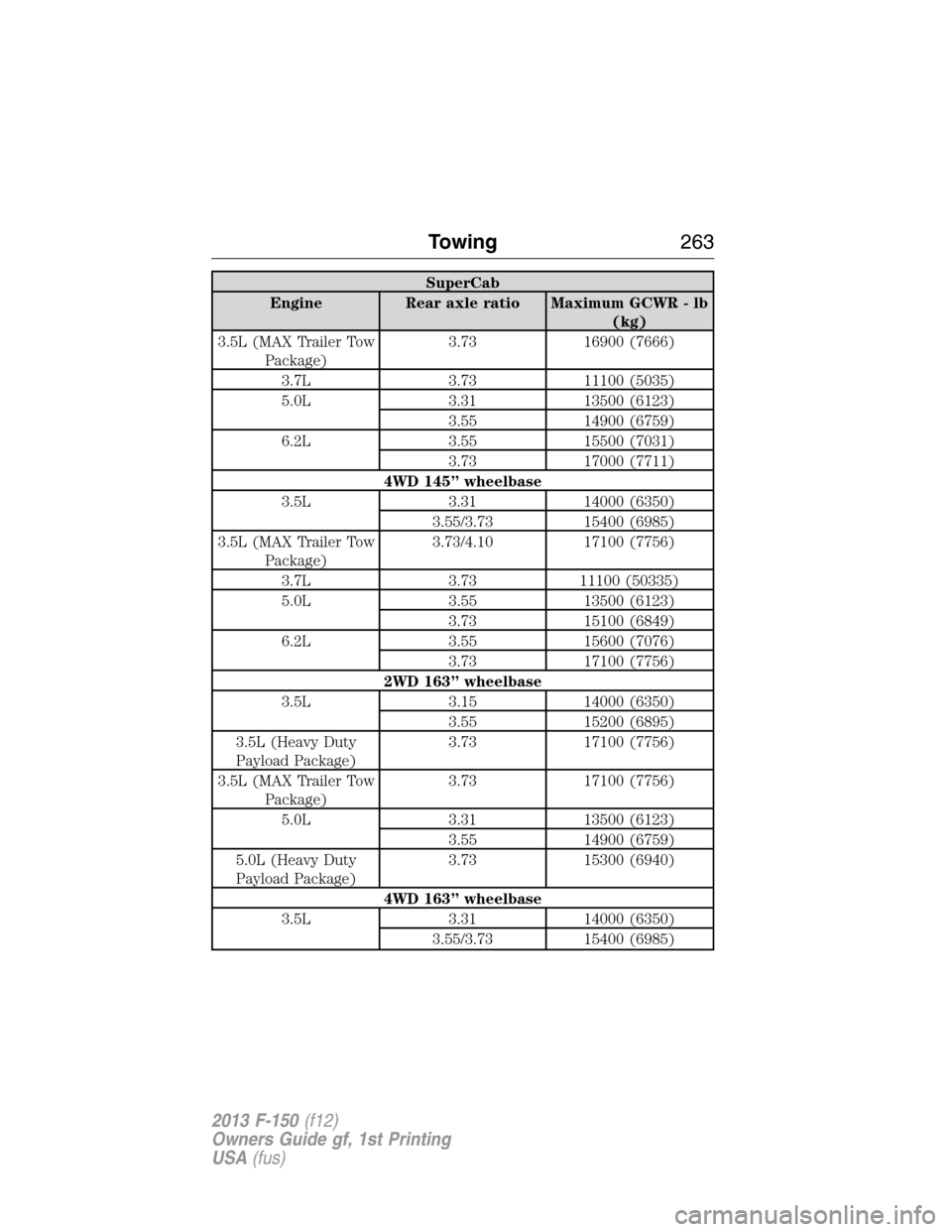
SuperCab
Engine Rear axle ratio Maximum GCWR - lb
(kg)
3.5L (MAX Trailer Tow
Package)3.73 16900 (7666)
3.7L 3.73 11100 (5035)
5.0L 3.31 13500 (6123)
3.55 14900 (6759)
6.2L 3.55 15500 (7031)
3.73 17000 (7711)
4WD 145” wheelbase
3.5L 3.31 14000 (6350)
3.55/3.73 15400 (6985)
3.5L (MAX Trailer Tow
Package)3.73/4.10 17100 (7756)
3.7L 3.73 11100 (50335)
5.0L 3.55 13500 (6123)
3.73 15100 (6849)
6.2L 3.55 15600 (7076)
3.73 17100 (7756)
2WD 163” wheelbase
3.5L 3.15 14000 (6350)
3.55 15200 (6895)
3.5L (Heavy Duty
Payload Package)3.73 17100 (7756)
3.5L (MAX Trailer Tow
Package)3.73 17100 (7756)
5.0L 3.31 13500 (6123)
3.55 14900 (6759)
5.0L (Heavy Duty
Payload Package)3.73 15300 (6940)
4WD 163” wheelbase
3.5L 3.31 14000 (6350)
3.55/3.73 15400 (6985)
Towing263
2013 F-150(f12)
Owners Guide gf, 1st Printing
USA(fus)
Page 264 of 570
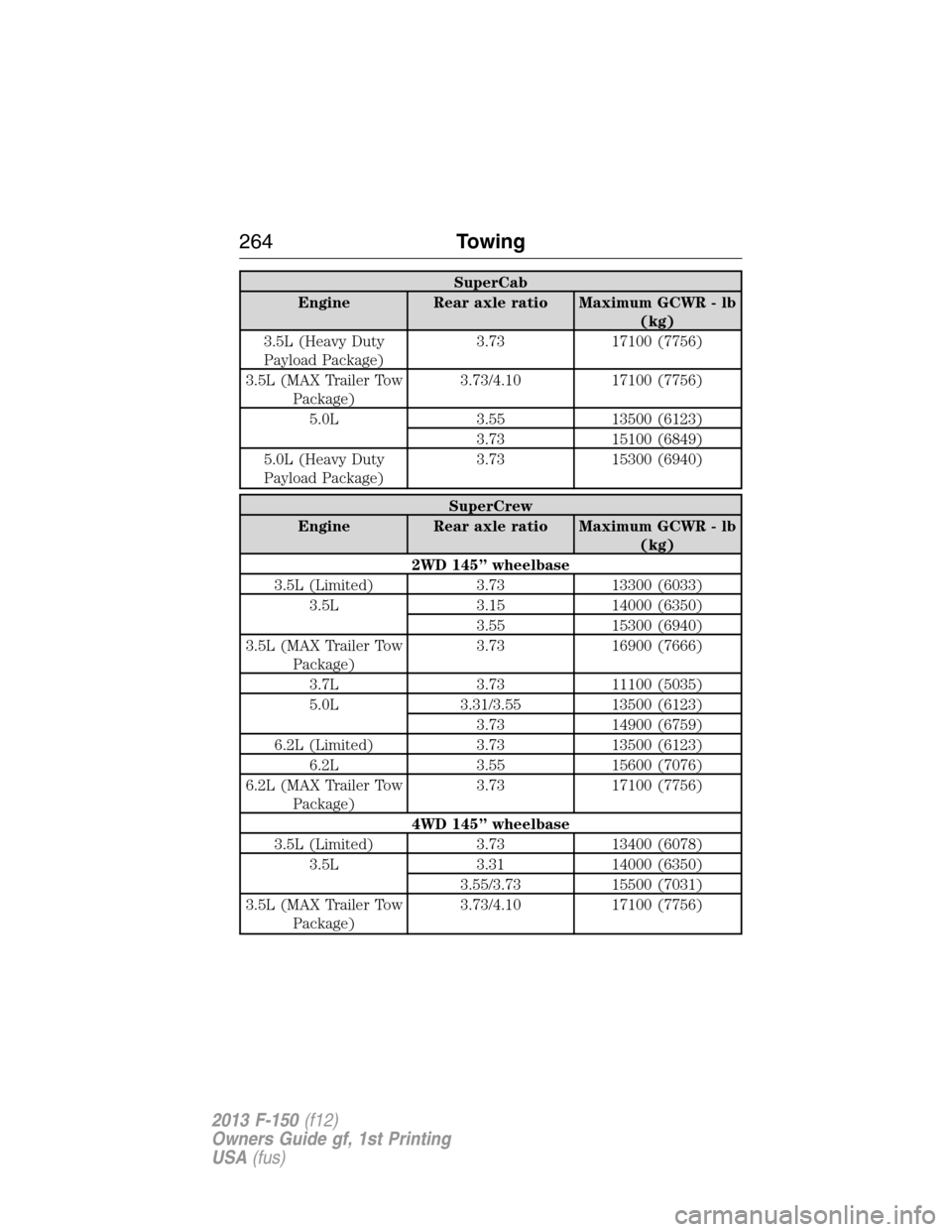
SuperCab
Engine Rear axle ratio Maximum GCWR - lb
(kg)
3.5L (Heavy Duty
Payload Package)3.73 17100 (7756)
3.5L (MAX Trailer Tow
Package)3.73/4.10 17100 (7756)
5.0L 3.55 13500 (6123)
3.73 15100 (6849)
5.0L (Heavy Duty
Payload Package)3.73 15300 (6940)
SuperCrew
Engine Rear axle ratio Maximum GCWR - lb
(kg)
2WD 145” wheelbase
3.5L (Limited) 3.73 13300 (6033)
3.5L 3.15 14000 (6350)
3.55 15300 (6940)
3.5L (MAX Trailer Tow
Package)3.73 16900 (7666)
3.7L 3.73 11100 (5035)
5.0L 3.31/3.55 13500 (6123)
3.73 14900 (6759)
6.2L (Limited) 3.73 13500 (6123)
6.2L 3.55 15600 (7076)
6.2L (MAX Trailer Tow
Package)3.73 17100 (7756)
4WD 145” wheelbase
3.5L (Limited) 3.73 13400 (6078)
3.5L 3.31 14000 (6350)
3.55/3.73 15500 (7031)
3.5L (MAX Trailer Tow
Package)3.73/4.10 17100 (7756)
264Towing
2013 F-150(f12)
Owners Guide gf, 1st Printing
USA(fus)
Page 265 of 570
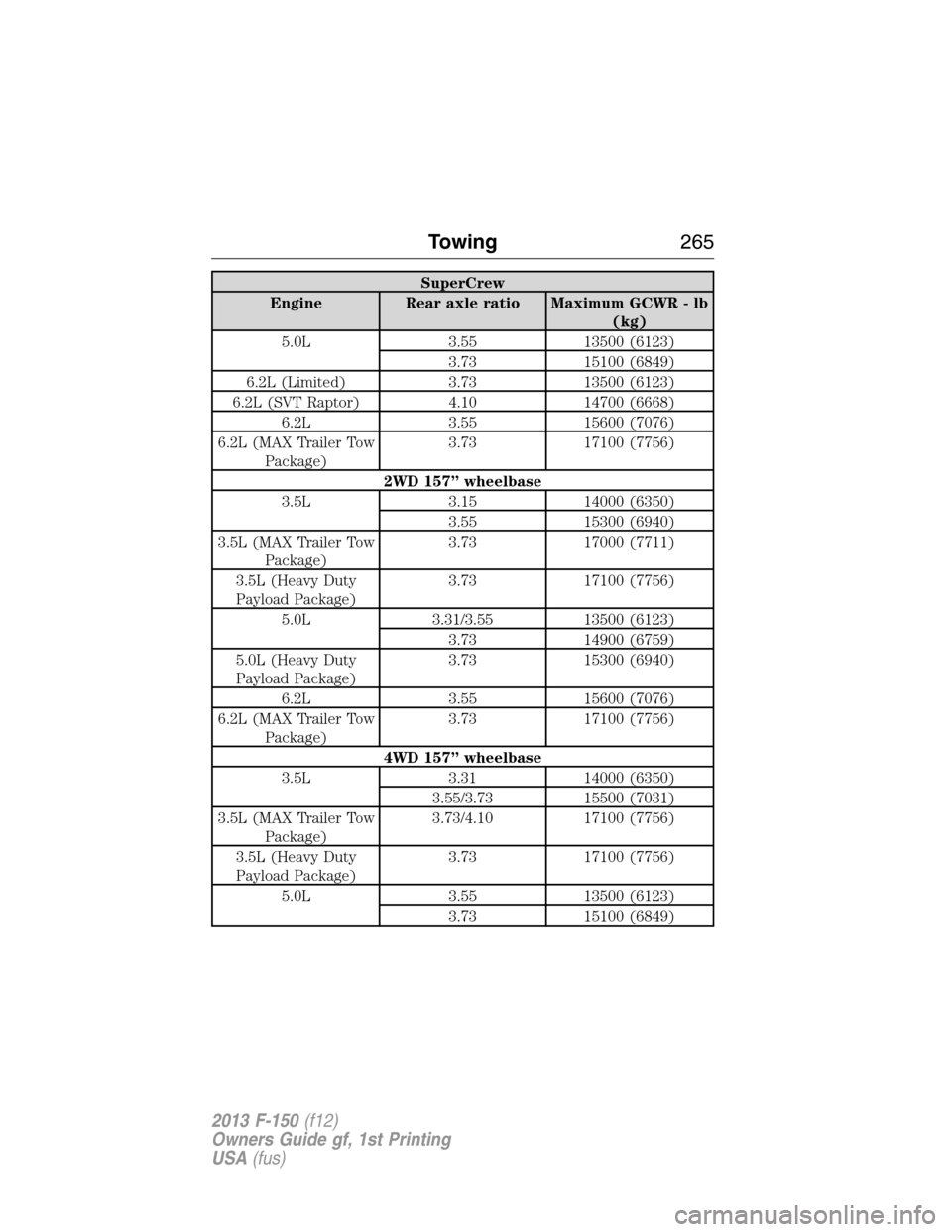
SuperCrew
Engine Rear axle ratio Maximum GCWR - lb
(kg)
5.0L 3.55 13500 (6123)
3.73 15100 (6849)
6.2L (Limited) 3.73 13500 (6123)
6.2L (SVT Raptor) 4.10 14700 (6668)
6.2L 3.55 15600 (7076)
6.2L (MAX Trailer Tow
Package)3.73 17100 (7756)
2WD 157” wheelbase
3.5L 3.15 14000 (6350)
3.55 15300 (6940)
3.5L (MAX Trailer Tow
Package)3.73 17000 (7711)
3.5L (Heavy Duty
Payload Package)3.73 17100 (7756)
5.0L 3.31/3.55 13500 (6123)
3.73 14900 (6759)
5.0L (Heavy Duty
Payload Package)3.73 15300 (6940)
6.2L 3.55 15600 (7076)
6.2L (MAX Trailer Tow
Package)3.73 17100 (7756)
4WD 157” wheelbase
3.5L 3.31 14000 (6350)
3.55/3.73 15500 (7031)
3.5L (MAX Trailer Tow
Package)3.73/4.10 17100 (7756)
3.5L (Heavy Duty
Payload Package)3.73 17100 (7756)
5.0L 3.55 13500 (6123)
3.73 15100 (6849)
Towing265
2013 F-150(f12)
Owners Guide gf, 1st Printing
USA(fus)
Page 266 of 570
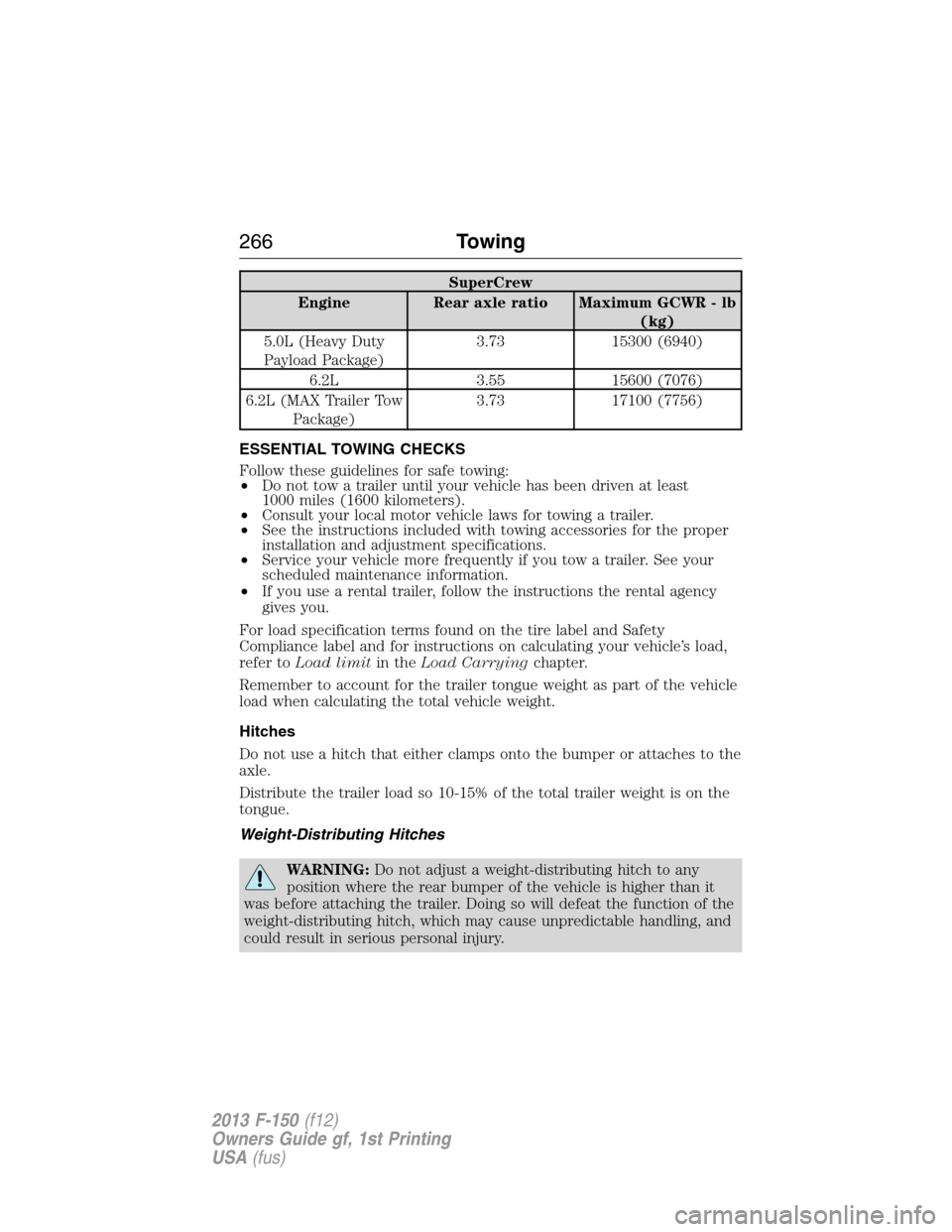
SuperCrew
Engine Rear axle ratio Maximum GCWR - lb
(kg)
5.0L (Heavy Duty
Payload Package)3.73 15300 (6940)
6.2L 3.55 15600 (7076)
6.2L (MAX Trailer Tow
Package)3.73 17100 (7756)
ESSENTIAL TOWING CHECKS
Follow these guidelines for safe towing:
•Do not tow a trailer until your vehicle has been driven at least
1000 miles (1600 kilometers).
•Consult your local motor vehicle laws for towing a trailer.
•See the instructions included with towing accessories for the proper
installation and adjustment specifications.
•Service your vehicle more frequently if you tow a trailer. See your
scheduled maintenance information.
•If you use a rental trailer, follow the instructions the rental agency
gives you.
For load specification terms found on the tire label and Safety
Compliance label and for instructions on calculating your vehicle’s load,
refer toLoad limitin theLoad Carryingchapter.
Remember to account for the trailer tongue weight as part of the vehicle
load when calculating the total vehicle weight.
Hitches
Do not use a hitch that either clamps onto the bumper or attaches to the
axle.
Distribute the trailer load so 10-15% of the total trailer weight is on the
tongue.
Weight-Distributing Hitches
WARNING:Do not adjust a weight-distributing hitch to any
position where the rear bumper of the vehicle is higher than it
was before attaching the trailer. Doing so will defeat the function of the
weight-distributing hitch, which may cause unpredictable handling, and
could result in serious personal injury.
266Towing
2013 F-150(f12)
Owners Guide gf, 1st Printing
USA(fus)
Page 267 of 570
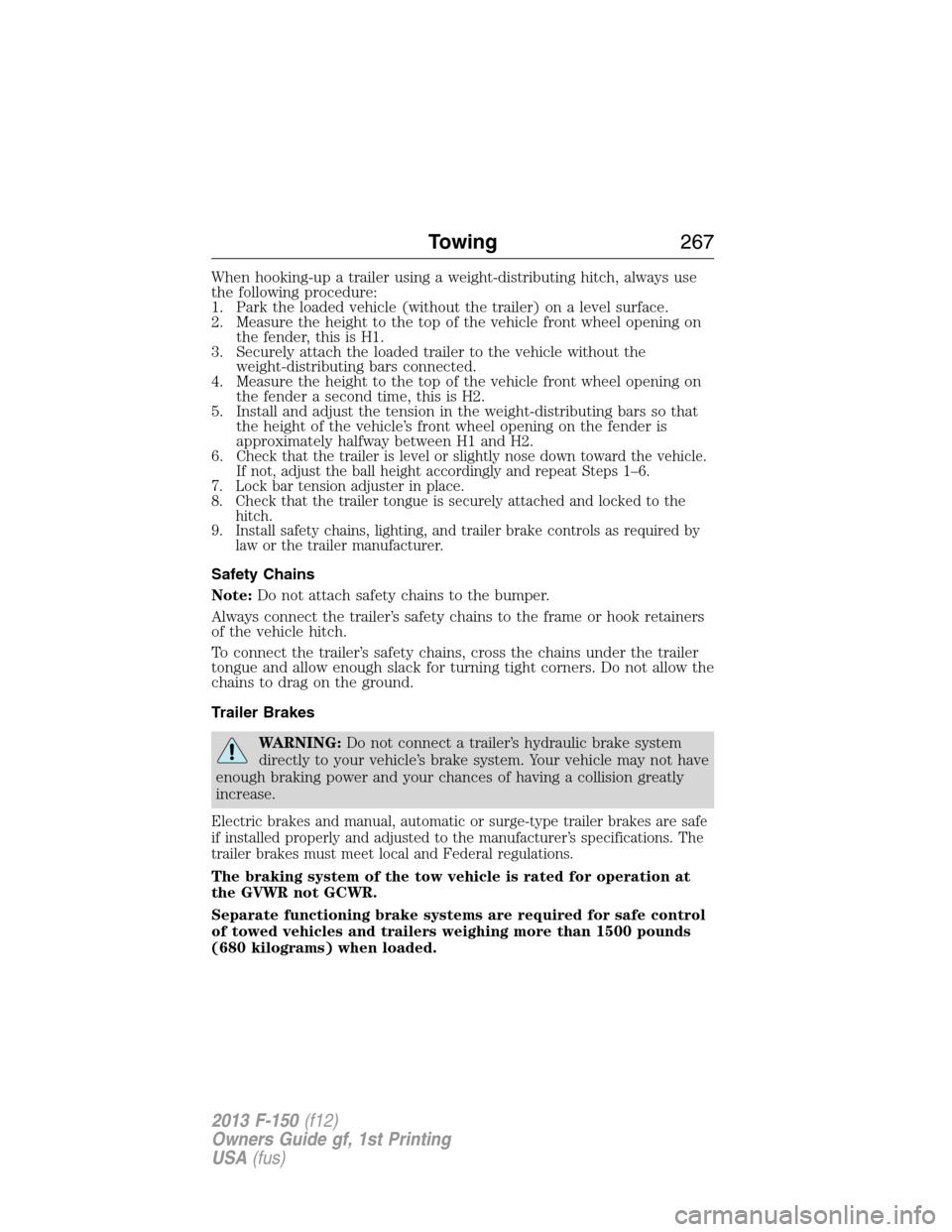
When hooking-up a trailer using a weight-distributing hitch, always use
the following procedure:
1. Park the loaded vehicle (without the trailer) on a level surface.
2. Measure the height to the top of the vehicle front wheel opening on
the fender, this is H1.
3. Securely attach the loaded trailer to the vehicle without the
weight-distributing bars connected.
4. Measure the height to the top of the vehicle front wheel opening on
the fender a second time, this is H2.
5. Install and adjust the tension in the weight-distributing bars so that
the height of the vehicle’s front wheel opening on the fender is
approximately halfway between H1 and H2.
6.
Check that the trailer is level or slightly nose down toward the vehicle.
If not, adjust the ball height accordingly and repeat Steps 1–6.
7. Lock bar tension adjuster in place.
8. Check that the trailer tongue is securely attached and locked to the
hitch.
9. Install safety chains, lighting, and trailer brake controls as required by
law or the trailer manufacturer.
Safety Chains
Note:Do not attach safety chains to the bumper.
Always connect the trailer’s safety chains to the frame or hook retainers
of the vehicle hitch.
To connect the trailer’s safety chains, cross the chains under the trailer
tongue and allow enough slack for turning tight corners. Do not allow the
chains to drag on the ground.
Trailer Brakes
WARNING:Do not connect a trailer’s hydraulic brake system
directly to your vehicle’s brake system. Your vehicle may not have
enough braking power and your chances of having a collision greatly
increase.
Electric brakes and manual, automatic or surge-type trailer brakes are safe
if installed properly and adjusted to the manufacturer’s specifications. The
trailer brakes must meet local and Federal regulations.
The braking system of the tow vehicle is rated for operation at
the GVWR not GCWR.
Separate functioning brake systems are required for safe control
of towed vehicles and trailers weighing more than 1500 pounds
(680 kilograms) when loaded.
Towing267
2013 F-150(f12)
Owners Guide gf, 1st Printing
USA(fus)
Page 268 of 570
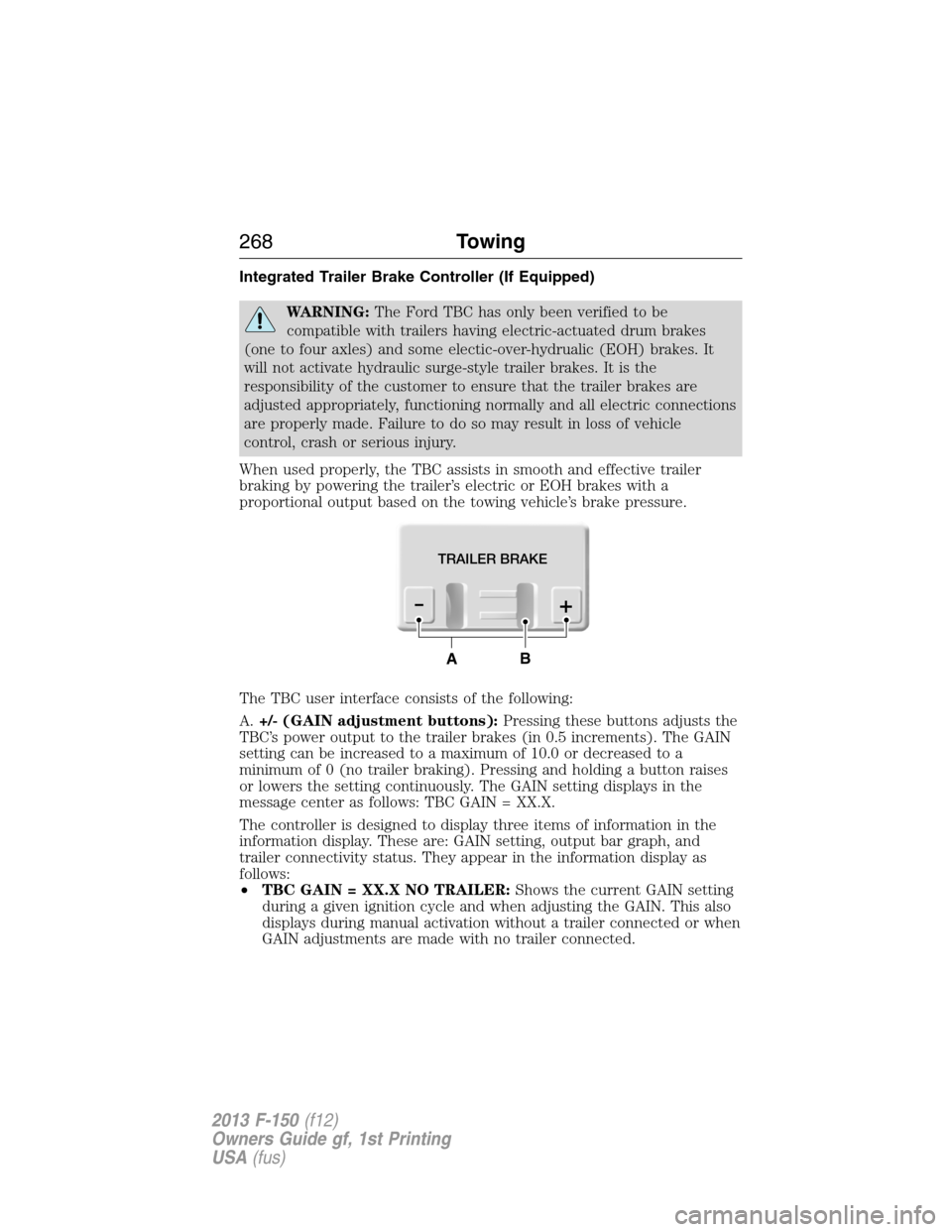
Integrated Trailer Brake Controller (If Equipped)
WARNING:The Ford TBC has only been verified to be
compatible with trailers having electric-actuated drum brakes
(one to four axles) and some electic-over-hydrualic (EOH) brakes. It
will not activate hydraulic surge-style trailer brakes. It is the
responsibility of the customer to ensure that the trailer brakes are
adjusted appropriately, functioning normally and all electric connections
are properly made. Failure to do so may result in loss of vehicle
control, crash or serious injury.
When used properly, the TBC assists in smooth and effective trailer
braking by powering the trailer’s electric or EOH brakes with a
proportional output based on the towing vehicle’s brake pressure.
The TBC user interface consists of the following:
A.+/- (GAIN adjustment buttons):Pressing these buttons adjusts the
TBC’s power output to the trailer brakes (in 0.5 increments). The GAIN
setting can be increased to a maximum of 10.0 or decreased to a
minimum of 0 (no trailer braking). Pressing and holding a button raises
or lowers the setting continuously. The GAIN setting displays in the
message center as follows: TBC GAIN = XX.X.
The controller is designed to display three items of information in the
information display. These are: GAIN setting, output bar graph, and
trailer connectivity status. They appear in the information display as
follows:
•TBC GAIN = XX.X NO TRAILER:Shows the current GAIN setting
during a given ignition cycle and when adjusting the GAIN. This also
displays during manual activation without a trailer connected or when
GAIN adjustments are made with no trailer connected.
TRAILER BRAKE
AB
268Towing
2013 F-150(f12)
Owners Guide gf, 1st Printing
USA(fus)
Page 269 of 570
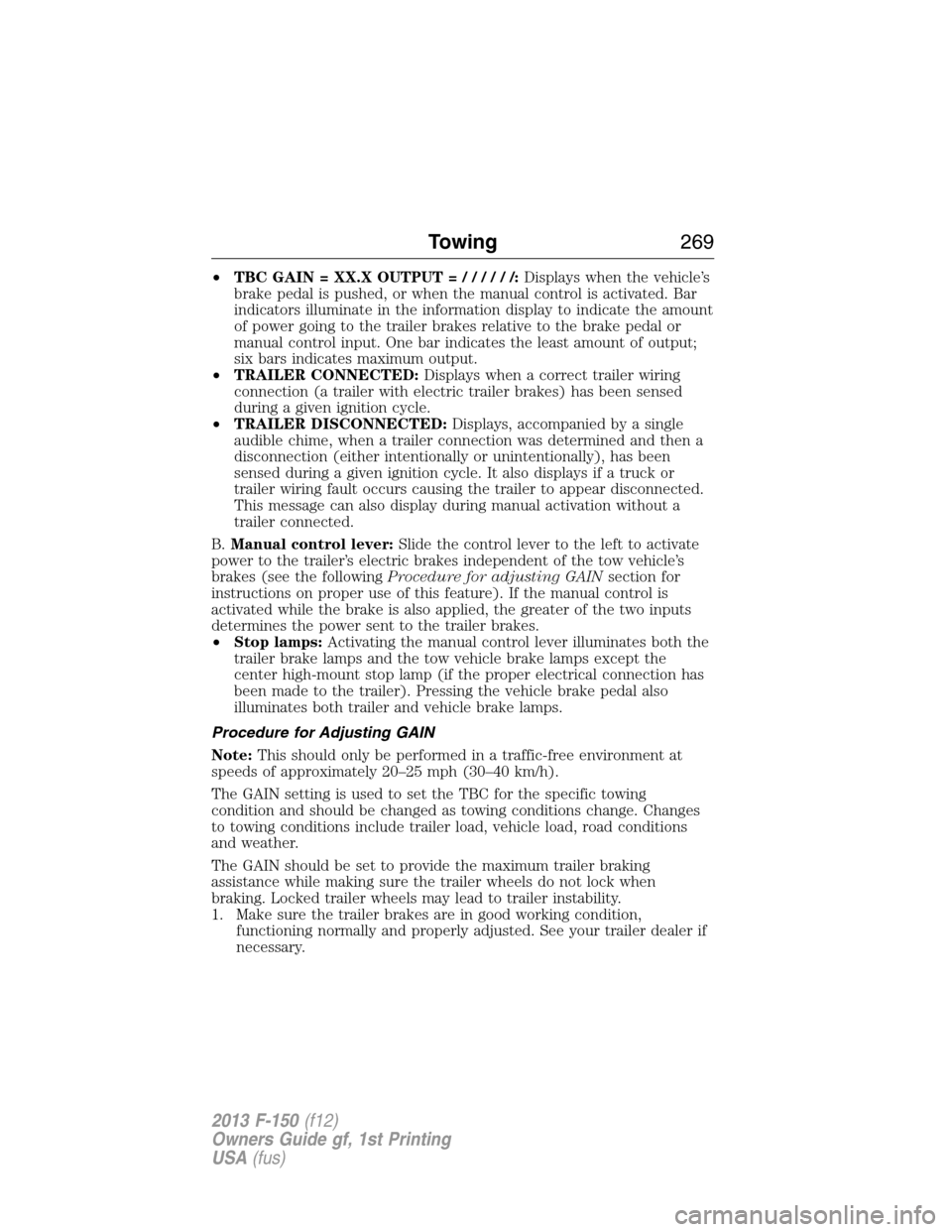
•TBC GAIN = XX.X OUTPUT=//////:Displays when the vehicle’s
brake pedal is pushed, or when the manual control is activated. Bar
indicators illuminate in the information display to indicate the amount
of power going to the trailer brakes relative to the brake pedal or
manual control input. One bar indicates the least amount of output;
six bars indicates maximum output.
•TRAILER CONNECTED:Displays when a correct trailer wiring
connection (a trailer with electric trailer brakes) has been sensed
during a given ignition cycle.
•TRAILER DISCONNECTED:Displays, accompanied by a single
audible chime, when a trailer connection was determined and then a
disconnection (either intentionally or unintentionally), has been
sensed during a given ignition cycle. It also displays if a truck or
trailer wiring fault occurs causing the trailer to appear disconnected.
This message can also display during manual activation without a
trailer connected.
B.Manual control lever:Slide the control lever to the left to activate
power to the trailer’s electric brakes independent of the tow vehicle’s
brakes (see the followingProcedure for adjusting GAINsection for
instructions on proper use of this feature). If the manual control is
activated while the brake is also applied, the greater of the two inputs
determines the power sent to the trailer brakes.
•Stop lamps:Activating the manual control lever illuminates both the
trailer brake lamps and the tow vehicle brake lamps except the
center high-mount stop lamp (if the proper electrical connection has
been made to the trailer). Pressing the vehicle brake pedal also
illuminates both trailer and vehicle brake lamps.
Procedure for Adjusting GAIN
Note:This should only be performed in a traffic-free environment at
speeds of approximately 20–25 mph (30–40 km/h).
The GAIN setting is used to set the TBC for the specific towing
condition and should be changed as towing conditions change. Changes
to towing conditions include trailer load, vehicle load, road conditions
and weather.
The GAIN should be set to provide the maximum trailer braking
assistance while making sure the trailer wheels do not lock when
braking. Locked trailer wheels may lead to trailer instability.
1. Make sure the trailer brakes are in good working condition,
functioning normally and properly adjusted. See your trailer dealer if
necessary.
Towing269
2013 F-150(f12)
Owners Guide gf, 1st Printing
USA(fus)
Page 270 of 570
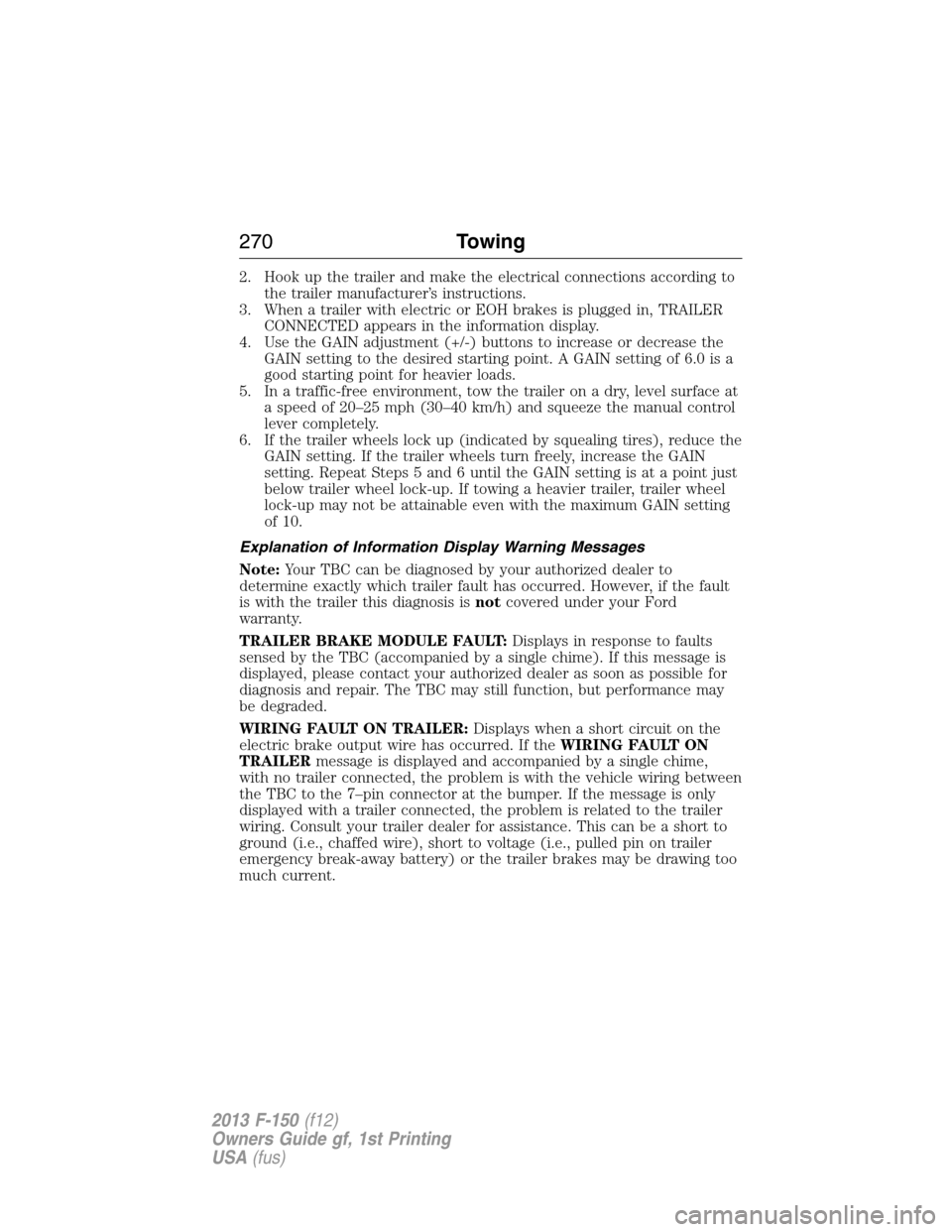
2. Hook up the trailer and make the electrical connections according to
the trailer manufacturer’s instructions.
3. When a trailer with electric or EOH brakes is plugged in, TRAILER
CONNECTED appears in the information display.
4. Use the GAIN adjustment (+/-) buttons to increase or decrease the
GAIN setting to the desired starting point. A GAIN setting of 6.0 is a
good starting point for heavier loads.
5. In a traffic-free environment, tow the trailer on a dry, level surface at
a speed of 20–25 mph (30–40 km/h) and squeeze the manual control
lever completely.
6. If the trailer wheels lock up (indicated by squealing tires), reduce the
GAIN setting. If the trailer wheels turn freely, increase the GAIN
setting. Repeat Steps 5 and 6 until the GAIN setting is at a point just
below trailer wheel lock-up. If towing a heavier trailer, trailer wheel
lock-up may not be attainable even with the maximum GAIN setting
of 10.
Explanation of Information Display Warning Messages
Note:Your TBC can be diagnosed by your authorized dealer to
determine exactly which trailer fault has occurred. However, if the fault
is with the trailer this diagnosis isnotcovered under your Ford
warranty.
TRAILER BRAKE MODULE FAULT:Displays in response to faults
sensed by the TBC (accompanied by a single chime). If this message is
displayed, please contact your authorized dealer as soon as possible for
diagnosis and repair. The TBC may still function, but performance may
be degraded.
WIRING FAULT ON TRAILER:Displays when a short circuit on the
electric brake output wire has occurred. If theWIRING FAULT ON
TRAILERmessage is displayed and accompanied by a single chime,
with no trailer connected, the problem is with the vehicle wiring between
the TBC to the 7–pin connector at the bumper. If the message is only
displayed with a trailer connected, the problem is related to the trailer
wiring. Consult your trailer dealer for assistance. This can be a short to
ground (i.e., chaffed wire), short to voltage (i.e., pulled pin on trailer
emergency break-away battery) or the trailer brakes may be drawing too
much current.
270Towing
2013 F-150(f12)
Owners Guide gf, 1st Printing
USA(fus)